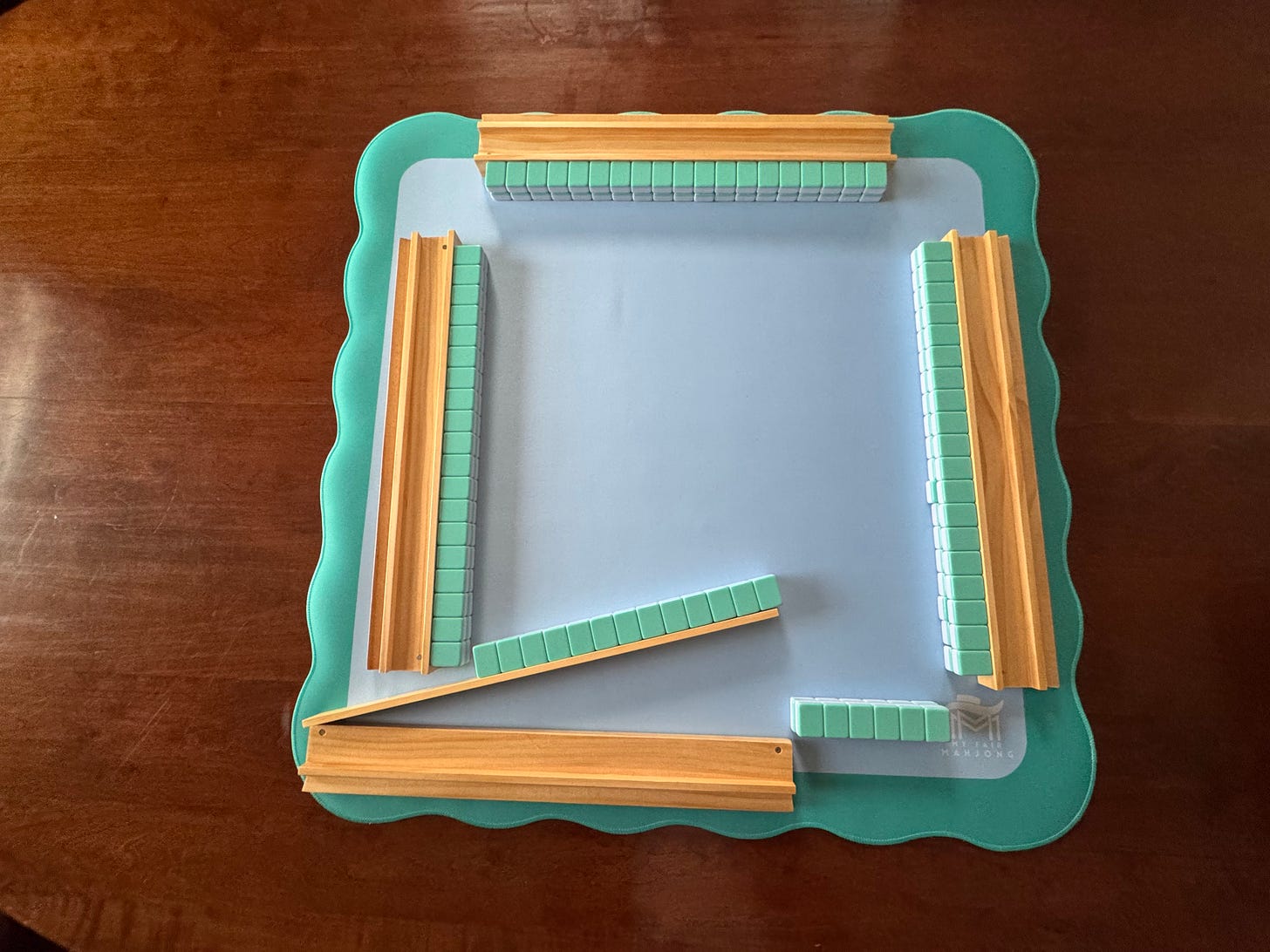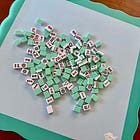This is a series of posts to teach you how to play Mahjong. We’ll cover dealing and The Charleston in this post, but make sure to subscribe to get access to upcoming posts:
Part 3: Playing to Win (coming soon!)
Now that you’re well versed on the elements of the game, it’s time to start playing. First things first, let’s deal.
Setting Up
Before starting, make sure all tiles are face down on the table and sufficiently mixed up (the equivalent of shuffling a deck of cards). Then have each person create a double-stacked row of 19 tiles in front of them (38 total). The row of tiles is referred to as a wall.
Determine the Dealer
Each player will roll the pair of dice. The person who rolls the highest sum becomes the dealer. The dealer is also referred to as East. Sometimes, the person in the East chair will be the dealer by default instead of selecting by a dice roll. You can choose which method you prefer or play the house rules of wherever you’re playing.
If you play more than one game, the person counterclockwise from the dealer will become the dealer on the second game.
Deal the Tiles
The dealer will then keep the same number of tile stacks as she rolled on the dice (i.e. if she rolled a two and a four, she’ll add that together to keep six stacks). The dealer uses her rack pusher to push the rest of the stack out to the middle of the table.

The dealer begins by taking four tiles (two stacks of two). Moving counterclockwise, the next person takes four tiles from the same end of the wall. This continues (moving counterclockwise) until everyone has 12 tiles. If the wall runs out of tiles during this time, the person counterclockwise from the dealer will push her wall out (shown below).

Once everyone has 12 tiles, the dealer will take the first and third tiles from the top layer of the wall. Still moving counterclockwise, the rest of the players will take one tile each. At this point, the dealer should have 14 tiles and everyone else should have 13.
Assess and Sort your Hand
You’ll want to review the game card to determine which hand(s) you might be able to play. It’s helpful to sort your hand to keep track of your progress. It’s useful to keep all jokers on the left end and sort by suit, pairs, consecutive numbers, etc. depending on the hand you think you might play.

The Charleston
After the initial Part of dealing the game is a tile exchange referred to as The Charleston. Since the game was brought to the US in the 1920s, it’s assumed that The Charleston got its name from the popular dance at the time.
The Mahjong Charleston has several steps, and it looks intimidating when you see them all written out. In reality, it’s just passing tiles to all the other players counterclockwise and then repeating it clockwise. All tiles are passed face down. Between each step, players can look at the tiles they were passed and reassess their hand.
To Do The Charleston:
All players pass three tiles to the player to the right
All players pass three tiles to the player across the table
All players pass three tiles to the player to the left
A blind pass is an option here. If you don’t have three tiles you want to get rid of, you can pass 1-3 tiles that were passed to you without looking at them. You’re gambling that the tile(s) you’re passing will not be useful to you.
If a player has a great hand at this point, they may not want to continue The Charleston. Any player can stop The Charleston after step three (even though the other players may be annoyed). If no one stops it, continue with the following steps:
All players pass three tiles to the player to the left
All players pass three tiles to the player across the table
All players pass three tiles to the right
Blind pass is an option here again.
Optional pass across: You and the player across from you can make a deal on whether you want to exchange 0-3 more tiles. The other two players make their own deal.
After the Charleston, you will want to reassess your tiles again to determine which hand you want to play on the game card. We’ll discuss how to read the card in the next post.
If all of this has your head spinning, don’t worry. It takes a few games to get used to it, but dealing and The Charleston become a fairly quick process once everyone has the hang of it. Take your time learning and have some fun along the way—it’s a game after all!
Next Up
Now that we’ve learned the elements of the game and how to deal, we’ll dive into how to play to win—or Mahjong!
In the meantime, I’d love to know who’s playing! Let me know in the comments if you’ve tried it out.
If you enjoyed this post, I invite you to give it a heart or restack and check out The Tea Library’s previous posts:






